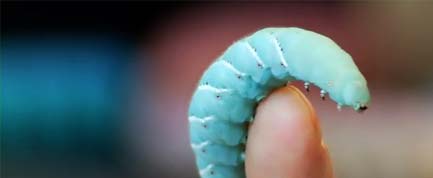Caterpillars Have a Crazy Crawl, Scientists Discover

Caterpillars apparently move about in a way unlike that seen in any other form of walking before — as they crawl, their guts slide forward before the rest of their body does.
These new insights are already influencing designs of soft-bodied robots of the future, scientists added.
Biologist Michael Simon of Tufts University in Massachusetts and his colleagues made the caterpillar discovery completely by accident. They were using X-ray beams to scan hawkmoth caterpillars (Manduca sexta) as they moved, expecting only to see fluids sloshing around inside the animals' bodies. Instead, they discovered the guts moving independently of the surrounding bodies.
"The moment the first caterpillar began to crawl in the beam, we immediately knew that we were looking at something very new," Simon said.
Free-floating guts
To better understand how the internal organs of the insects might lurch around on their own, the researchers recorded the caterpillars using both X-rays and visible light. These revealed that at the start of each caterpillar crawl, the gut in the insect's mid-body segments moved forward in advance of the body wall and before the attached limbs swung forward. The gut then fell back surprisingly quickly, in a piston-like motion.
There have been previous examples of internal organs moving around inside mammals and birds, but those were always the result of simple inertia. For example, the livers of horses can slide back and forth as the animals gallop along, Simon said.
Sign up for the Live Science daily newsletter now
Get the world’s most fascinating discoveries delivered straight to your inbox.
If one were to open up a caterpillar to understand how this happens, one would see what is essentially an open bag lined with muscle, Simon explained, and its digestive system — a fairly simple tube running from the mouth to the anus — is suspended inside. With no walls separating one body segment from the next, the gut can move about freely, driven back and forth by muscles connected to the body wall at the front and back of the caterpillar.
Analyzing the movements proved tricky. The researchers ultimately had to synchronize both visible and X-ray videos, digitizing the animals' motions, and writing and running video-processing tools and programs that helped analyze gut actions.
Caterpillar applications
The researchers suspect what they found in the hawkmoths will apply to other caterpillars and perhaps a few other creatures, such as leeches. It remains uncertain whether this sliding gut movement offers the caterpillars any benefits, although the researchers conjecture separating the motions of the guts from jostling caused by crawling might allow their viscera to concentrate on digestion and fuel their growth.
"When we consider the primary functions of a caterpillar — eat and grow — it seems all the more important that nothing interfere with either of these functions," Simon said. It remains possible that sliding guts could also offer the caterpillars some kind of unknown mechanical advantage when crawling in complicated, three-dimensional spaces, he added.
Simon and his colleagues noted these findings are already contributing to their efforts to design and develop soft-bodied robots, which might be better equipped than your average droid to squeeze into tight spaces. Simon added that having a free-floating gut like those in caterpillars might give such robots some very useful cargo room.
"One of the big advantages of a soft robot is the ability to move cargo, such as electronics, tools, or chemicals," Simon told LiveScience. "A robot with a skeleton has a fixed structure, but a soft-bodied robot can deform, both to the outside environment and to the interior contents."
The scientists detailed their findings online July 22 in the journal Current Biology.
- Top 10 Animal Senses Humans Don't Have
- Civilized Caterpillars Talk With Their Butts
- 10 Animals That Use Tools











